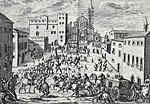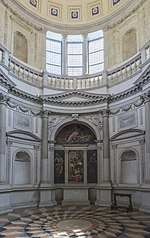Stadio Marcantonio Bentegodi
1963 establishments in Italy1990 FIFA World Cup stadiumsBuildings and structures in VeronaFootball venues in ItalySerie A venues ... and 4 more
Sport in VeronaSports venues completed in 1963Sports venues in VenetoTourist attractions in Verona

The Stadio Marcantonio Bentegodi is a stadium in Verona, Italy. It is the home of Hellas Verona of Serie A and was also the home of Chievo Verona, a former football club, until 2021. It also hosts the Women's Champions League matches of Bardolino Verona, some youth team matches, rugby matches, athletics events and occasionally even musical concerts. With 39,211 total seats, of which only 31,045 are approved, it is the eighth-largest stadium in Italy by capacity. The stadium is named after the historic benefactor of Veronese sport, Marcantonio Bentegodi.
Excerpt from the Wikipedia article Stadio Marcantonio Bentegodi (License: CC BY-SA 3.0, Authors, Images).Stadio Marcantonio Bentegodi
Piazzale Olimpia, Verona Borgo Milano
Geographical coordinates (GPS) Address Nearby Places Show on map
Geographical coordinates (GPS)
| Latitude | Longitude |
|---|---|
| N 45.435355555556 ° | E 10.968647222222 ° |
Address
Piazzale Olimpia
37138 Verona, Borgo Milano
Veneto, Italy
Open on Google Maps










